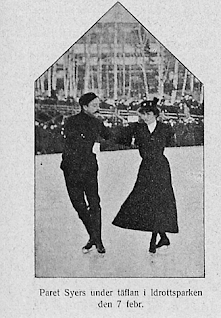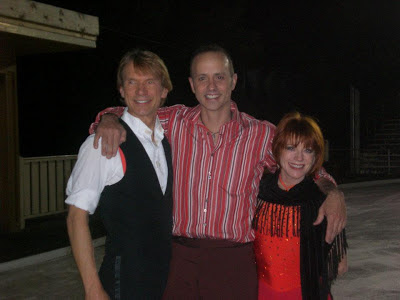Photo courtesy "Ice & Roller Skate" magazine
In northeastern Spain, near the French border in the midst of the Pyrenees lies a town with ancient roots. Jaca, Spain was the fortified city out of which Aragon was developed. It was Aragon's capital until 1097 and its territory traces back to wars in the first century BC between Sertorious and Pompey. To this day, medieval walls and towers surround an eleventh century Romanesque cathedral in the town and the city's 16th century citadel remains a popular tourist attraction. The history and mystery of this beautiful area provided a backdrop for an event that changed the historical path of professional figure skating.
The Campeonatos del Mundo de Patinaje Artístico Professional Sobre Hielo, or World Professional Figure Skating Championships was an open professional figure skating competition held sixteen times between 1974 and 1998 and featured skaters from over thirty countries in that time. Competitors over the years in this prestigious competition which was broadcast widely in Europe have included Barbara Underhill and Paul Martini, Denise Biellmann, Liz Manley, Gary Beacom, Anita Hartshorn and Frank Sweiding, Scott Williams, Paul McGrath, Lorna Brown, Doug Mattis, Petr Barna, Jozef Sabovcik, Charlene von Saher, Sandra and Val Bezic, Robert Wagenhoffer, Lori Nichol, Karen Preston, Brian Pockar, Calla Urbanski and Rocky Marval, Lisa-Marie Allen, Charlene Wong, Alexandr Fadeev and Sandra Garde.
The event was subsidized in part by the town of Jaca to aid tourism, with the remainder of the funds raised by the sale of television rights. The Summer 1980 edition of "Canadian Skater" magazine noted, "Three contestants in each category are invited, though expenses are only paid for the first two accepted. There is no national standing at stake, but a purse of 150,000 pesetas ($2,000) is first prize; the prizes are proportionately less foir second and third place. The contestants are chosen by the professional skating organization of their country, and the names then submitted to the World Professional Organization for acceptance... The judges are also chosen by their own national organization." In 1979, the entire four-day competition was aired on Spanish television... right down to the practice sessions. The judging panel consisted of six judges, each assigned one aspect of the skater or team's performance to evaluate (jumps, spins, originality of composition, etc.). The marks of the 'seventh judge' were the averages of marks by ten random audience members, who judged on Public Impression.
Lorna (like myself) is a firm believer that events such as these are important and can totally happen again. "The PSA is so brainwashed by the ISU system that it's really hard to get them to support it. If they aren't running it, it's really hard to get them to be supportive. It's all politics - political power," she acknowledged. "All you need is one rink." She made a really good point I agree with completely. She pointed out that with things like YAS (Young Artists Showcase) which are done online primarily with the exception of the final, a lot of the leg work in organizing an event like this can be done ahead of time. You can accept applications online, do biographies of the skaters online and have the skating at a live event in a rink donated for a week, for instance. "We would want people like Stephane Lambiel, Daisuke Takahashi - but they don't have to be champions," she said. She also explained that skaters participating in a revival of an event like this would have to be true professionals and not be competing in ISU events. In other words, this would not be a pro-am. She made another great point that "there are so many more skaters than there ever was. A lot won't do it unless they get paid a fortune. It should be more honor than money, to get it started at least". She explained that when she competed and won in 1974, she paid her own flight and that for something like reviving an open professional competition to work, at first the right thing to do would be to ask skaters to maybe pay their hotel expenses or get a rink donated for a week. It would have to start small. We talked more about the skaters that an event like this would need to attract. Names we both threw out there (in addition to Lambiel and Takahashi) including Jeffrey Buttle, Jeremy Abbott, Emanuel Sandhu, Joannie Rochette, Shawn Sawyer, Misha Ge, Nicole Bobek and Shae-Lynn Bourne. Lorna pointed out that professional competition shouldn't be about who lands a quad and that someone like Shae-Lynn Bourne "can skate an AMAZING program without a jump at all!" For the very first champion of this event to say how much she'd like to see something like this resurface and help the sport grow speaks volumes about the open mind that people need to have about the way the sport is developing artistically and that reviving professional competition is only a pipe dream if people accept it as one. "Anything you can imagine, you can make a reality," said Lorna Brown, a beautiful skater who toured the world with one of the most artistic skaters of all time, the legendary John Curry.
Simone Grigorescu-Alexander. Photo courtesy Toronto Public Library, from Toronto Star Photographic Archive. Reproduced for educational purposes under license permission.
Ten years later in 1984, Romania's Simone Grigorescu-Alexander bested thirteen other skaters from seven other countries to win the World Professional Championships in Jaca, Spain. The year previous she unfortunately had to withdraw and before that, in her visit in 1982, she finished second out of twenty competitors. Her fourth and final visit came during the last year the competition was held when it was revived for a final time in 1998 following the Nagano Olympics. "The last time I participated was years later and it was only for the joy of participation and not so much for the sake of the competition," explained Simone. "Jaca was a very special place and the championship was like no other I have ever taken place in. Very unique experience, very unique people and a wonderful feeling of collaboration and sharing rather than the elitist feeling lots of other pro championships have had. I miss it dearly and Pablo, its creator and driving force (he passed away much too early, years ago)." She elaborated on the feeling of comradery amongst the skaters participating. "In Jaca, though you were competing against one another, it felt like a team where everyone is pulling for everyone to skater their best performance and win the hearts of the judges and the crowd! Very special indeed!"
Simone Grigorescu-Alexander offered some insight into the way the Jaca event was judged. "We had to skate a short and a long program. I think the short did have some requirements that were modeled after the competitive system of those times, like: one solo jump, one two jump combination, one Axel type jump, solo spin, combination spin and footwork sequence...perhaps three spins. Too long ago to remember. Rules, but very loose ones. The long program was whatever you wanted it to be! As far as I can remember, we were judged on various elements such as jumps and spins, choreography, musicality, interpretation, footwork and such. I do not remember how many exactly. Robin Cousins was a judge one year and may remember. Then, the last mark consisted of a group of 10 local people who were not knowledgeable about skating and their vote made up the popular vote. If you were able to entertain the locals, you could get a perfect 10 even if you performed no jumps or spins. The great thing about Jaca is that entertainment was the name of the game. We had no requirements that boxed the performer into a rigid and strict format. We had total freedom to create whatever we as artists felt would entertain the crowd. Yes, if you wanted to get decent marks in jumps and spins and in footwork and such you needed to show those elements but you knew that those were only a couple of marks... I have seen beautiful and engaging performances without any jumps and I have seen performances that had me roaring with laughter! These did not perhaps win but the prize money was minimal, thus you went to Jaca for the experience and perhaps to get a title... Mostly for the experience and as a creative outlet. Most performances that won combined all aspects of skating entertainment to win the judges and the public: jumps, spins, footwork, great musicality and musical interpretation of the piece, great choreography and were able to create a character that the public would enjoy! So much fun! I still have video from my last competition, of the men's event as I was already done. I am amazed at the quality of entertainment even to this day!"
Skate Guard is a blog dedicated to preserving the rich, colourful and fascinating history of figure skating. Over ten years, the blog has featured over a thousand free articles covering all aspects of the sport's history, as well as four compelling in-depth features. To read the latest articles, follow the blog on Facebook, Twitter, Pinterest and YouTube. If you enjoy Skate Guard, please show your support for this archive by ordering a copy of the figure skating reference books "The Almanac of Canadian Figure Skating", "Technical Merit: A History of Figure Skating Jumps" and "A Bibliography of Figure Skating": https://skateguard1.blogspot.com/p/buy-book.html.





















.jpg)
